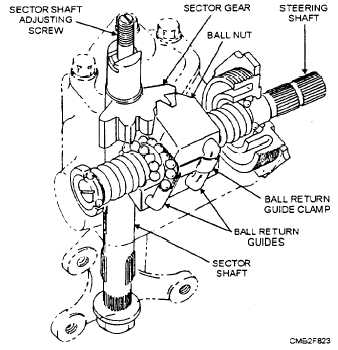The recirculating ball is the most common type of worm and nut steering gear (fig. 8-23). In this steering gear, the nut, which is in the form of a sleeve block, is mounted on a continuous row of balls on the worm gear to reduce friction. Grooves are cut into the ball nut to match the shape of the worm gear. The ball nut is fitted with tubular ball guides to return the balls diagonally across the nut to recirculate them, as the nut moves up

Figure 8-23. - Worm and nut steering gear (recirculating ball type).
and down on the worm gear. With this design, the nut is moved on the worm gear by rolling instead of sliding contact. Turning the worm gear moves the nut and forces the sector and pitman arm shaft to turn.
Rack and Pinion
The rack-and-pinion steering gear has become increasingly popular on smaller passenger vehicles. It is simpler, more direct acting, and may be straight mechanical or power-assisted.
The manual rack-and-pinion steering gear basically consists of a steering gear shaft, pinion gear, rack. thrust spring, bearings, seals, and gear housing. In the rack-and-pinion steering system the end of the steering gear shaft contains a pinion gear, which meshes with a long rack (fig. 8-24). The rack is connected to the steering arms by tie rods, which are adjustable for maintaining proper toe angle. The thrust spring preloads the rack-and-pinion gear teeth to prevent excessive gear backlash. Thrust spring tension may be adjusted by using shims or an adjusting screw.
As the steering wheel is rotated, the pinion gear on the end of the steering shaft rotates. The pinion gear moves the rack from one side to the other. This action pushes or pulls on the tie rods, forcing the steering knuckles or wheel spindles to pivot on their ball joints. This turns the wheels to one side or the other so the vehicle can be steered.

Figure 8-24. - Rack-and-pinion steering gear.
Continue Reading